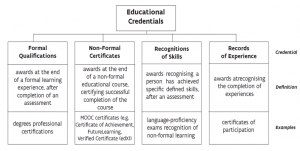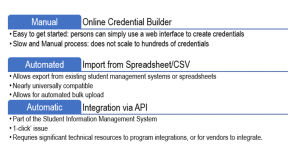Module 1: How to include alternative, innovative, open credentials
Landing the Concept
This module will help to raise awareness and understanding of key concepts related to digital credentials and how they can be used to implement innovative credentials as part of your institutional certification. You will learn what type of digital tools will support their implementation, available providers and how to select tools that better fit to your institutional purposes and legacy systems.
A credential, in its most essential form, is a documented statement awarded from one party to another describing the latter qualities. When referring to educational credentials, those are testimonials or certified documents showing that a person is entitled to credit or has a right to exercise official power (Merriam-Webster Dictionary- Credential definition) as the holder has achieved certain learning outcomes and thus qualifies for specific function/position.As depicted in the following figure, there are different types of credentials according to the type of settings (formal or non-formal), the type of recognition (educational, labour market), acquired competences (knowledge, skills or attitudes) and level of achievement (participation, completion).

Figure 1 Types of educational credentials (Camilleri A. a., 2018)
At a high-level, digital credential documents may take three forms: basic digital versions of paper-based documents, unsigned digital documents, and digitally signed documents.
Digital versions of paper-based documents represent the basic and lowest level of credential documents, and they mainly consist of reproductions of paper documents. These are usually scanned versions or photographs of paper certificates. For many low-security applications, these can be considered as equivalent to paper documents. As in the strict sense of digital technology view, they are typically not considered ‘true’ digital certificates and are not further discussed in the course.
At a high-level, digital credential documents may take three forms: basic digital versions of paper-based documents, unsigned digital documents, and digitally signed documents.
Digital versions of paper-based documents represent the basic and lowest level of credential documents, and they mainly consist of reproductions of paper documents. These are usually scanned versions or photographs of paper certificates. For many low-security applications, these can be considered as equivalent to paper documents. As in the strict sense of digital technology view, they are typically not considered ‘true’ digital certificates and are not further discussed in the course.
However, digital signing of documents has yet to be commonplace because there is no universally used open standard for digital signatures, leading to certificates that can only be verified within the context of specific software ecosystems. Furthermore, correctly implementing signature protocols adds a large degree of complexity to any system, increasing price and often decreasing ease of use. Digital signatures also require the involvement of third-party certificate providers to guarantee the integrity of the transaction – these third parties have significant control over every aspect of the certification and verification process, which can be abused – often using exploitative pricing models. Although distributed ledger based on blockchain technologies potentially solve many of the issues around digital signatures and there are working examples like the European Blockchain Services Infrastructure (European Commission) their implementation is still being broadly tested and only will be ready for production environments after 2022.
A recognition process is another aspect to consider when designing, implementing or using a digital credential Recognition. It requires a credential to be:
- presented to a verifying party for a particular purpose.
- accepted as authentic by the verifying partying.
- accepted as appropriate for the purpose for which it was presented by the verifying party.
While within an educational environment ‘recognition’ typically refers to the acknowledgement of competences achieved in a previous learning experience, such recognition requires that credential contents should be received, read and verified by a verifier. Thus, in the case of digitally signed credentials, digital means are required to ensure:
- the ability of a verifier to receive a digital document via a network, according to a commonly agreed format with the issuer/sharer.
- the verification of the authenticity of the document either by reference against a registry, or by verifying a digital signature.
- the processing of the content of the document according to the formats and schemas laid out by a data standard/model.
- the resulting status ‘educational recognition’ that is conferred upon the contents or holder of a credential as a result of that processing.
Once we had introduced basic concepts about digitally signed credentials, let’s check which are their most common implementations nowadays:
Micro-credentials: The concept of micro-credentials has been gaining increasing interest amongst educational institutions and especially in the context of higher education. A micro-credential is a small volume of learning certified by a digital credential. It explicitly defines learning outcomes in terms of specific knowledge, skills or competences with an indication of the associated workload required to achieve such outcomes (Camilleri A., 2019) Micro-credentials can be generally defined as sub-unit of a credential or credentials that can be stacked into larger credentials. In terms of workload, they can be ranged from 2-30 ECTS.
Moreover, micro-credentials have been considered favourable for personalised learning opportunities by allowing learners upskill or reskill themselves with competences that are demanded in the current and upcoming labour market (European Commission, 2020).
Digital badges are an implementation of another type of verifiable digital micro-credentials which includes an indicator of accomplishment, skill, quality, or interest that can be displayed, accessed, and verified online. They are commonly used for low-stakes credentials, i.e., modules of a qualification or attending a conference. They use shapes, colours, and symbols to represent levels of achievement and are designed to be easy to embed across different types of platforms. The IMS Open Badges specification (IMS Open Badges, 2018) describes, from a technical perspective, a method for packaging information about accomplishments and recognition embedding it into portable image files as digital badges and establishing resources for its validation and verification.
European Digital Credentials for Learning (EDCs) are electronically sealed, and tamper-evident digital records given to a person to certify the learning they have undertaken. (European Commission, 2020a) They can be awarded for formal education, training, online courses, volunteering experiences and more. Some examples of learning achievements that EDC can describe are attendance to/ or participation in specific activities, assessments completed (e.g., projects), skills or competences achieved, professional entitlements (e.g., registration as a apothecary) and qualifications (e.g., Graduate University studies).
Now you have a better idea about basic concepts related to digital credentials, next step is to get familiarised with the digital tools which will support their implementation.
European Digital Credentials for Learning Infrastructure (EDCI). Europass is one of the 12 flagship actions of the European Skills Agenda adopted by the European Commission on 1 July 2020. (Digital Agenda) The new Europass (Europass) offers a range of online ‘e-Portfolio’ tools and information for people of all ages to manage their lifelong learning and career such as:
- a personal profile for people to record all their skills, qualifications and experiences,
- tailored suggestions of jobs and courses for registered users based on their interests and skills,
- updated tools for creating CVs and cover letters and
- information on learning and working in Europe.
As part of the new Europass, the Commission has also developed the European Digital Credentials Infrastructure (EDCI, 2020) a set of tools and mechanisms to allow the issuing, storage, sharing of European Digital Credentials and supporting their recognition across Europa. Currently there are over 2 million Europass wallets registered and ready to receive and store EDC format compliant digitally signed credentials.
As presented in the following image, the EDCI issuer portal provides organizations with three modalities to award digital signed credentials. When selecting one or other option issuers should consider the number of credentials to issue and their organization internal technical resources to support the awarding process.

Figure 2 EDCI issuer portal awarding (issuing) modalities
Badgr (Badgr, 2020) helps organizations to create learning ecosystems to support skills-based digital credentials, stackable learning pathways, and portable learner records. It was founded in 2015, its headquarters are based in Oregon, USA and Microsoft, Startbucks, Mozilla, AI Singapore, SAP, CISCO networking academy, Arizona State University and more than 2400 organizations spanning 160 countries compose the Badgr client base.
Badgr allows LMS integration, as Blackboard or Canvas and helps to create skill-based credential systems that organize user’s learning experiences by building stackable credential pathways that incorporate professional certifications and achievements from third-party organizations. As it supports independent skills definitions and connects its client-designed badges to real-time labour market information and job opportunities. Badgr was one of the first two platforms to be IMS Global Open Badges 2.0 certified 2.0 compliant across all three implementation roles of Issuer, Host, and Displayer (Global, 2020).
Azure AD verifiable credentials (Microsoft Azure, 2020) provides a platform to digitally generate, present and verify customized verifiable credentials that an organization’ employees, contractors, vendors, or customers can use in multiple scenarios. Azure AD verifiable credentials is now used by Keio University, Japan; the National Health Service (NHS) in the UK, the Flanders Government of Belgium (Azure, 2020a)
It is based on the use of DIDs (decentralized credentials) user-generated, self-owned, globally unique identifiers rooted in decentralized systems like ION (Identity Overlay Network). They possess unique characteristics, like greater assurance of immutability, censorship resistance, and tamper evasiveness. These attributes are critical for any ID system that is intended to provide self-ownership and user control.
Microsoft’s verifiable credential solution uses DIDs to cryptographically sign as proof that a relying party (verifier) is attesting to information proving they are the owners of a verifiable credential. While DID User Agent/Wallet: Microsoft Authenticator App enables real people to use decentralized identities and Verifiable Credentials
When selecting specific tools for supporting issuing/awarding digital credentials, you will need to assess the appropriateness of those tools in terms of effectiveness criteria such as: copyright, data privacy and DGPR compliance and compatibility and interoperability of those tools regarding your institution legacy systems and devices used by the stakeholders involved in the process.
As you are familiar with the basic concepts and tools to support the implementation of credentials, you will be asking yourself: How to implement innovative credentials as part of my institutional certification? The following guide will help you to find the answers:
Step 1: Collect rich data about your courses: basic metadata, learning outcomes, assessment, grading scheme, recognition information. Usually, such information is included as part of the course curriculum design/ programme and publicly available at your institution website/ learning management system.
Step 2: Determine the type of credentials you want to implement and establish its level of granularity: Programme Level, Module Level, Individual Achievements. Please bear in mind that fully digital-signed credentials are recommended for Programme level, while micro-credentials and or digital badges are more suitable for Module level and individual achievements. In the case of using EDC infrastructure all possible granularity levels are supported by European Digital credentials for learning.
Step 3: Define Issuing Workflow: Who is responsible for preparing credentials? Who is responsible for adding grading information? Who is responsible for issuing credentials? Answers to previous questions depends on each institution’s organogram and the workflow for issuing digital credentials is like the paper-based counterpart but will be supported by the specific supporting software selected for creating/issuing digital credentials.
Step 4: Pilot Digital Credentials: First select cross-section of courses from across the Institution/Issuing infrastructure. Primary candidates will be those courses promoting transversal competences to different study programmes.
- 4.1 Train involved academic and non-academic staff in the benefits of using digital credentials and the process of issuing them according to the results of step 2.
- 4.2 Educate students in mechanics of earning digital credentials and benefits of owning and sharing such credentials.
- 4.3 Issue: Once the course is completed proceed issuing digital and paper-based credentials to students.
Step 5: Validate & Improve: During this step you will need to assess the process and results obtained in the previous step. To do so, it will be recommended to
- 5.1 Collect feedback from your main stakeholders: students, employers, academic and non-academic staff who participated in the piloting experience.
- 5.2 Assess Value Added: Make a comparative Costs analysis of the Paper vs. Digital credentials issuing process in addition to a Return of Investment analysis considering benefits of issuing digital credentials vs. paper-based ones.
- 5.3 Recommend: Considering the results of the added value analysis and all collected feedback, create a set of recommendations for Institutional Policies, Technologies and Functionalities and best fit for purpose Data Models to be used.
Step 6: Integrate recommendations into your existing quality system considering a set of minimum technical criteria, minimum data format, lifecycle policies based on the recommendations from the previous step.
Step 7: Make Credentials Official: This will require to complete the process of making an official decision of the University allowing for Digital credential Issue as institutional practice and once such decision will be taken, an Information document describing Credential Policy should be published using all institutional channels.
Step 8: Mainstream (scale your pilot experience):
- 8.1 Establish which Technology Platform will be used based on the results of step 6.
- 8.2 Train staff in benefits and mechanics of digital credentials using the guidelines used in step 4.1 and the recommendations resulting from the step 5.3
- 8.3 Educate students in mechanics and benefits of digital credentials using the guidelines used in step 4.2 and the recommendations resulting from the step 5.3
- 8.4 Issue digital and paper-based credentials to students using tools available after completing 7.1.
Now you had been introduced to the basic concepts related to innovative credentials we invite you to explore the following resources which will help you to get more details about the process of implementing them.
- Please read the document entitled “Assuring the Quality of Credentials to support Learning Innovation” This a seminal paper about the digital educational credentials quality which provides working definitions and examples for digital educational credentials, and the elements of a credential statement required to ensure its quality in terms of recognition. Furthermore, it includes a matrix describing which conditions should be met to ensure a digital credential will be distinct, authentic, accessible, exchangeable, and portable.
- Read chapter to understand key advantages of using digital signed credentials in terms of identification, awarding, storage, verification and sharing.
- Check the video entitled “) from origin to future prospects”, European Digital credentials can be a simple certificate about the completion of a short non formal learning activity or as complex and detailed as the description of a university degree or a diploma supplement. The video provides an overview of EDC framework origins, its main definitions and functions and as well as the components or building blocks of the supporting technical EDC infrastructure. It stresses the opportunity of ensuring interoperability at European level in terms of learning offerings and credentials.
Take Action!
- Prepare a proposal for your institution to implement one of the innovative credentials introduced in the course as part of the institutional certifications. Please bear in mind future impacts of such implementation in terms of international recognition. Do not forget to include details about the type of credentials, the course/program to issue such credentials and information regarding the different steps to follow to complete the credential implementation.
- With some colleagues of their institution, discuss about a proposal, ask for opinions about an idea, look for someone who has started an activity related to the module, etc. This discussion can be proposed with a face-to-face approach, in a virtual meeting, by using some web tool or service, etc.
- Share your idea / proposal / findings with others, find three strong / weak points of the posed proposal, give feedback to a proposal from other partner, widen the idea of another partner, etc.
Test Yourself
References
- Azure, M. (2020a). Microsoft Azure Customer stories. Retrieved from https://didproject.azurewebsites.net/
- Badgr. (2020). Badgr. Retrieved from https://info.badgr.com/
- Camilleri, A. (2019, October 19). Micro Credentials 101: What are they and why should we care? Retrieved from MicroHE MasterClass, Bled Slovenia.: https://microcredentials.eu/wp-content/uploads/sites/20/2019/10/20191021-Policy-Roadmaps-for-MicroCredentials.pdf
- Camilleri, A. a. (2018). Assuring the Quality of Credentials to support Learning Innovation. 13th European Quality Assurance Forum – Broadening the scope of QAAt: Vienna. Vienna. Retrieved from https://www.researchgate.net/publication/329059732_Assuring_the_Quality_of_Credentials_to_support_Learning_Innovation
- Digital Agenda. (2020). Commission presents European Skills Agenda for sustainable competitiveness, social fairness and resilience. Retrieved from https://ec.europa.eu/social/main.jsp?langId=en&catId=89&newsId=9723&furtherNews=yes&preview=cHJldkVtcGxQb3J0YWwhMjAxMjAyMTVwcmV2aWV3
- EDCI. (2020). Europass Digital Credentials Issuers portal. Retrieved from https://europa.eu/europass/digital-credentials/issuer/#/home
- Europass (n.d.). European Union Europass. Retrieved from https://europa.eu/europass/en
- European Commission. (2020a). What are Digital Credentials. Retrieved from https://europa.eu/europass/en/what-are-digital-credentials
- European Commission (n.d.). European Blockchain Services Infrastructure. Retrieved from https://digital-strategy.ec.europa.eu/en/policies/european-blockchain-services-infrastructure
- European Commission (2020). Retrieved from Achieving the European Education Area by 2025 - Communication: https://ec.europa.eu/education/resources-and-tools/document-library/eea-communication-sept2020_en
- Global, I. (2020). Badgr IMS Open Badges Certified compliance. Retrieved from https://site.imsglobal.org/certifications/concentric-sky/badgr
- IMS Open Badges (2018). Retrieved from https://openbadges.org/
- Merrian-Webster Dictonary- Credential definition (n.d.). Retrieved from Merrian-Webster Dictonary: https://www.merriam-webster.com/dictionary/credential
- Microsoft Azure (2020). Introduction to Azure Active Directory Verifiable Credentials. Retrieved from Microsoft Azure: https://docs.microsoft.com/en-us/azure/active-directory/verifiable-credentials/decentralized-identifier-overview
- W3C (2019). W3C Verifiable Credentials Data Model 1.0. Retrieved from W3C Verifiable Credentials Data Model 1.0: https://www.w3.org/TR/vc-data-model/#what-is-a-verifiable-credential
